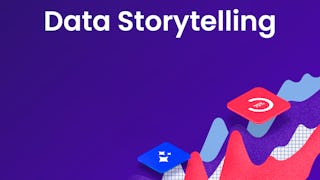In this course, you'll learn to contextualize qualitative and quantitative data to improve business decisions. You'll explore data collection tools, compare data-driven and data-inspired approaches, and understand why analysis can sometimes fail. You'll examine performance metrics and use data visualization to communicate the story behind the numbers. You'll study dashboard types, design principles, and mathematical thinking strategies to spot patterns to solve problems. Finally, you'll practice selecting the right analytical tools for different datasets based on their characteristics.


您将学到什么
Discuss the importance and benefits of dashboards and reports to the data analyst with reference to Tableau and spreadsheets
Explain the difference between quantitative and qualitative data including reference to their use and specific examples
Compare and contrast data-driven decision making with data-inspired decision making
Discuss the use of data in the decision-making process
您将获得的技能
要了解的详细信息
了解顶级公司的员工如何掌握热门技能

积累特定领域的专业知识
- 向行业专家学习新概念
- 获得对主题或工具的基础理解
- 通过实践项目培养工作相关技能
- 获得可共享的职业证书

该课程共有3个模块
Analysts contextualize individual data points and interpret them to inform business decisions. Qualitative and quantitative data are crucial elements of this process. You'll learn about data collection tools, how to compare data-driven and data-inspired decisions, and why data analysis can fail.
涵盖的内容
3个视频3篇阅读材料1个作业
Data visualization and metrics are widely utilized to convert raw data into useful information. You'll learn tools for visualizing data, the types of dashboards, and how metrics are used to measure performance.
涵盖的内容
2个视频2篇阅读材料2个作业
Mathematical thinking helps break down problems into smaller parts and identify the right tools for analysis, which often depend on dataset size. You'll also explore the characteristics, challenges, and benefits of big and small data.
涵盖的内容
1个视频1篇阅读材料2个作业
获得职业证书
将此证书添加到您的 LinkedIn 个人资料、简历或履历中。在社交媒体和绩效考核中分享。
位教师

提供方
从 Data Analysis 浏览更多内容
 状态:免费试用
状态:免费试用 状态:免费试用
状态:免费试用 状态:免费试用
状态:免费试用DeepLearning.AI
 状态:免费试用
状态:免费试用
人们为什么选择 Coursera 来帮助自己实现职业发展




常见问题
Data is a group of facts that can take many different forms, such as numbers, pictures, words, videos, observations, and more. We use and create data everyday, like when we stream a show or song or post on social media.
Data analytics is the collection, transformation, and organization of these facts to draw conclusions, make predictions, and drive informed decision-making.
No prior experience with spreadsheets or data analytics is required. All you need is high-school level math and a curiosity about how things work.
You don't need to be a math all-star to succeed in this certificate. You need to be curious and open to learning with numbers (the language of data analysts). Being a strong data analyst is more than just math, it's about asking the right questions, finding the best sources to answer your questions effectively, and illustrating your findings clearly in visualizations.
更多问题
提供助学金,
¹ 本课程的部分作业采用 AI 评分。对于这些作业,将根据 Coursera 隐私声明使用您的数据。

 中
中


